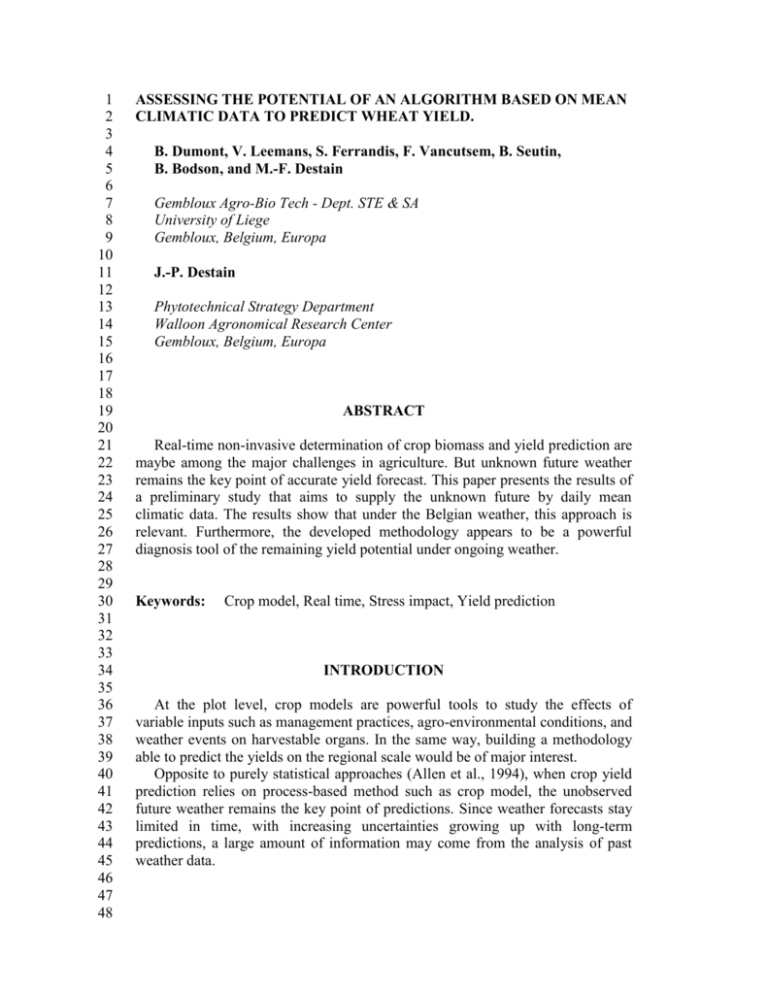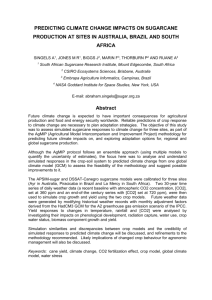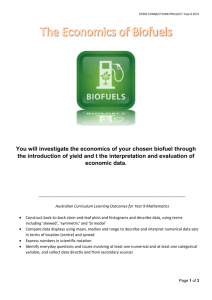A MODEL FOR WHEAT YIELD PREDICTION BASED ON
advertisement

1 2 3 4 5 6 7 8 9 10 11 12 13 14 15 16 17 18 19 20 21 22 23 24 25 26 27 28 29 30 31 32 33 34 35 36 37 38 39 40 41 42 43 44 45 46 47 48 ASSESSING THE POTENTIAL OF AN ALGORITHM BASED ON MEAN CLIMATIC DATA TO PREDICT WHEAT YIELD. B. Dumont, V. Leemans, S. Ferrandis, F. Vancutsem, B. Seutin, B. Bodson, and M.-F. Destain Gembloux Agro-Bio Tech - Dept. STE & SA University of Liege Gembloux, Belgium, Europa J.-P. Destain Phytotechnical Strategy Department Walloon Agronomical Research Center Gembloux, Belgium, Europa ABSTRACT Real-time non-invasive determination of crop biomass and yield prediction are maybe among the major challenges in agriculture. But unknown future weather remains the key point of accurate yield forecast. This paper presents the results of a preliminary study that aims to supply the unknown future by daily mean climatic data. The results show that under the Belgian weather, this approach is relevant. Furthermore, the developed methodology appears to be a powerful diagnosis tool of the remaining yield potential under ongoing weather. Keywords: Crop model, Real time, Stress impact, Yield prediction INTRODUCTION At the plot level, crop models are powerful tools to study the effects of variable inputs such as management practices, agro-environmental conditions, and weather events on harvestable organs. In the same way, building a methodology able to predict the yields on the regional scale would be of major interest. Opposite to purely statistical approaches (Allen et al., 1994), when crop yield prediction relies on process-based method such as crop model, the unobserved future weather remains the key point of predictions. Since weather forecasts stay limited in time, with increasing uncertainties growing up with long-term predictions, a large amount of information may come from the analysis of past weather data. 1 2 3 4 5 6 7 8 9 10 11 12 13 14 15 16 17 18 19 20 21 22 23 24 25 26 27 28 29 30 31 32 33 34 35 36 37 38 39 40 41 42 43 44 45 46 47 48 Simulations based on mean climatic data (Semenov and Porter, 1995) over the past years and stochastically generated data (Lawless and Semenov, 2005) are two possible ways to compensate the lack of future data. But the second approach has the disadvantage to be computationally heavy and sometimes under-representative of the reality (Mavromatis and Hansen, 2001). This research aims to demonstrate that it is possible to predict plant growth in advance using mean climatic data over the last years in combination with actual data. MATERIALS AND METHODS Original data Field experiments were carried out to measure the crop response (Triticum aestivum L.) under temperate climate (Belgium) and different nitrogen fertilisation levels. In this paper, we only consider a nitrogen rate fertilisation level of 180 kgN/ha (or uN), applied in three times, at tillering (60uN), redress (60uN) and last leaf stages (60uN). The experimental plots are implemented in real conditions since the crop season 2008-2009. Up to now, three successive years with much contrasted data were monitored. During the season 2008-2009, yields were quite high and close to the optimum of the cultivar, mainly explained by the good weather conditions and the sufficient nitrogen nutrition level. The seasons 2009-2010 and 2010-2011 were known to induce deep water stresses and were characterised by important yield losses. During last both seasons, the stresses did not appear at the same crop stages. Regular biomass growth references measurements (LAI, total biomass and grain yield) and continuously monitored environmental measurements (climatic data and soil moisture) were performed over the growing seasons. Eventually a 30-years weather database provided by a meteorological station located 4km from the field was available for the methodology building up. Crop model The soil-crop model STICS was used in this study. A wide literature can be found concerning the STICS model formalisms and the way it simulates the yields (Brisson et al., 2003; Brisson et al., 2009). The STICS model requires daily weather climatic inputs, namely minimum and maximum temperatures, total radiation and total rainfall. In the case of more complex formalisms about potential evapotranspiration calculation, the wind speed and vapour pressure are needed. The STICS model parameterisation, involving calibration and validation, was performed on the three years database previously presented. The contrasted years in term of climate and yields were useful to parameterise the crop water and thermal stresses dependence. For the experimental recorded crop season, data acquired by in-field wireless network were compared with the data issued from the meteorological station. For each climatic variable, the results were found in good accordance. Provided that the input data used to calibrate the model were representative enough to ensure 1 2 3 4 5 6 7 8 9 10 11 12 13 14 15 16 17 18 19 20 21 22 23 24 25 26 27 28 29 30 31 32 33 34 35 36 37 38 39 40 41 42 43 44 45 robustness, last remark implicitly allows us to use the 30-years database as input of the STICS model. Generation of the climatic matrix ensembles The first step of the methodology was to calculate daily mean climatic data. Each climatic year was considered as a matrix whose dimensions are the number of climatic variables and the number of days in the year. For each variables and each day of the year, a daily mean value was computed as the mean of the thirty corresponding values in each climatic matrix of the weather database. Applying the methodology over each day of the year and for all the climatic variables leads to generate the mean climate matrix. In a second step, a set of matrix, called a matrix ensemble, was generated for each year of the database. On basis of the mean climate matrix, the matrix ensemble was built replacing at a 10-days rate the averages values by the real data of the corresponding year. Finally, the STICS crop model was run on all the climatic matrix ensembles. All the simulations were run using the same initial value (soil water and nitrogen content) and following the same management itineraries. In all cases the crop was sown in late October (23th of October). RESULTS AND DISCUSSIONS Yield simulation over a matrix ensemble Fig. 1. presents the grain yields obtained with a given matrix ensemble, in this case the matrix ensemble based on the season 2005-2006. The season was known for not being supportive to good yield. The solid black line represents the grain yield obtained with a full real climate, while the dotted dark line corresponds to the full mean climate simulation. The light grey lines represent the different mean and real climate combinations. The right graph on Fig. 1. presents the final grain yield value obtained with corresponding days of really monitored climate, and remaining hypothetic mean future. The results as presented on the right graph of Fig. 1. quantifies instantly the losses or the gains, due to the last (ten) days weather conditions. In such a way, the methods allow to determine if the last (ten) days weather conditions led to better production or not than the average climate. For this reason, the proposed methodology gives a value that should be called the remaining potential yield. Finally, the yield obtained with full real climate can be surrounded by error prediction boundaries (dashed black lines on Fig. 1). In this case, an interval of one ton.ha-1 was considered, which correspond more or less to a ten percent error on the predictions. Seeing the bad climatic conditions of the crop season 20052006, the yields could only have been predicted around 15th of July (first point of the final yield curve involved within the error prediction boundaries) Mean Real Evol. 12 12 10 Grain yield [ton/ha] Grain yield [ton/ha] 10 8 6 8 6 4 4 2 2 Mean Evol. 0 1 2 3 4 5 6 7 8 9 10 11 12 13 14 15 16 17 18 19 20 21 22 23 24 25 26 27 28 29 30 31 0 50 100 150 200 250 No. of observed days since sowing 300 0 0 50 100 150 200 250 No. of observed days since sowing 300 Fig. 1. Grain yield daily simulations based on the Matrix Ensembles 20052006 (left) - Evolution of the final grain yield value vs. evolving climatic combination of real and mean climate (right) - Solid black line : full mean climate - Dotted black line (right) : full real climate - Dashed black line (left) : error boundaries on full real prediction - Light grey line : different combinations of real and mean climate. Yield prediction The Fig. 2. presents the results when the methodology is applied on all the climatic year of the database. The final real yields range between -45% and +10% of the initial predictions (12.2 tons/ha) made with average weather. So, the mean climate simulations do not necessarily lead to the best grain yields answer. Furthermore, the observations of Fig. 2. shows that the worst climatic conditions generally occurred a first time around the middle of April, and were more common after the middle of May. Practically, this may have important impacts in terms of decision making towards the crop calendar of management itinerary. To perform yield prediction, a common practice is to plot the cumulative probability distribution of the first day for which the yield could have been predicted (Fig. 3). Each grain yield predictive curve has thus to be surrounded by an upper and lower boundary, as made on Fig. 1. Applying the method on the thirty curves led to the results presented in Fig. 3 and Table 1. As detailed in Table 1, it appears possible to predict wheat yields in advance with a determined accuracy (±1ton.ha-1) and a reasonable risk (10%) around the 19th of July. This corresponds approximately to one month anticipation on a harvest date generally situated around the 15th of August, in Belgium. 15 14 Grain yield [ton/ha] 13 12 11 10 9 8 7 6 Mean Evol. 0 50 1 2 3 4 5 6 100 150 200 250 No. of observed days since sowing 300 Fig. 2. Evolution of the final grain yield vs. mean and real climate combinations for all the Matrix Ensembles - Solid black line : full mean climate - Grey line : different combinations of real and mean climate. 1 0.9 Probability of Prediction 0.8 0.7 0.6 0.5 0.4 0.3 0.2 0.1 0 140 160 7 8 9 10 11 12 260 280 Fig. 3. Cumulative distribution functions of yield forecast. Table 1. First day for which yield could be predicted. Probability Grain Yield ± 1.0t/ha 13 14 15 180 200 220 240 No. of observed days since sowing 0.95 19Jul 0.90 19Jul 0.75 09Jul 0.50 28Jun 1 2 3 4 5 6 7 8 9 10 11 12 13 14 15 16 17 18 19 20 21 22 23 24 25 26 27 28 29 30 31 32 33 34 35 36 37 38 39 40 41 42 43 44 45 46 47 48 CONCLUSION The novel form of results presentation allows studying the yields distributions along the season and over the years. This lead (i) to highlight the most sensitive periods inducing severe stress(es) on the crop, (ii) to quantify the immediate yield losses due the consecutive stresses, and (iii) to significantly estimate the date of final yield (±10%) prediction. The study shows that the yields could be predicted around the middle of July (30 days before harvest). Deeper investigations lead us to determine that the most damaging weather conditions appear generally after late May, slightly before the grains apparition. Applied as a preliminary study, the methodology turned out to be a powerful site-specific diagnosis tool of the potential yield of a defined crop under a set of real climatic conditions. Finally, the methodology has the potential to be used as a real-time decision support system to adapt management strategies after daily evaluation of the remaining yield potential. ACKNOWLEDGEMENT The authors would like to thanks the DGARNE for its financial support. REFERENCES Allen, R., Hanuschak, G.A., Craig, M.E., 1994. Forecasting crop acreages and yield in the face of and in spite of floods, Crop Yield Forecasting Methods. Proceedings of the Seminar Villefranche- sur-Mer: 24-27 October, Villefranchesur-Mer 87-110. Brisson, N., Gary, C., Justes, E., Roche, R., Mary, B., Ripoche, D., Zimmer, D., Sierra, J., Bertuzzi, P., Burger, P., Bussière, F., Cabidoche, Y.M., Cellier, P., Debaeke, P., Gaudillère, J.P., Hénault, C., Maraux, F., Seguin, B., Sinoquet, H., 2003. An overview of the crop model stics. European Journal of Agronomy 18(3–4) 309-332. Brisson, N., Launay, M., Mary, B., Beaudoin, N., 2009. Conceptual basis, formalisations and parameterization of the STICS crop model. Editions Quae. Collection Update Sciences and technologies. Lawless, C., Semenov, M.A., 2005. Assessing lead-time for predicting wheat growth using a crop simulation model. Agricultural and Forest Meteorology 135(1–4) 302-313. Mavromatis, T., Hansen, J.W., 2001. Interannual variability characteristics and simulated crop response of four stochastic weather generators. Agricultural and Forest Meteorology 109(4) 283-296. Semenov, M.A., Porter, J.R., 1995. Climatic variability and the modelling of crop yields. Agricultural and Forest Meteorology 73(3–4) 265-283.







